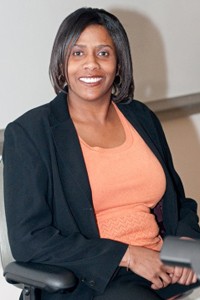
UC Creates Permanent Ties with the National Underground Railroad Freedom Center
Thanks to a gift to the Department of Africana Studies in the McMicken College of Arts and Sciences, Associate Professor of History Nikki Taylor joins Africana Studies in a newly created community professorship. The position will help foster a formal relationship between the National Underground Railroad Freedom Center and the University of Cincinnati.
Your research has heavily focused on Cincinnati black historysince even before you arrived at UC five years ago. What makes Cincinnatis history unique?
That is correct: I have had a longer relationship with the citys history than I have had with the city. I have only lived here 6 years, but my research began in 1997. I was attracted to Cincinnati because it has an intriguing, but conflicted history. On one hand, its history illuminates a city that embodied the deepest aspirations of a young nation, with a booming economy, racial, ethnic and religious diversity, and new and innovative ideas. Yet that same city had an ugly underbellya history fraught with racial violence, attempts at ethnic cleansing, and religious and political intolerance and proscription. I have always been intrigued by how one 19th century city could simultaneously represent Americas greatest possibilities, yet its worst side. Intrigue aside, Cincinnatis history is a useful tool to teach about race and ethnic relations. So, for me, the citys history provides the opportunity to promote racial understanding, tolerance and healing.
Youve been working closely with the Freedom Center since its inception. Tell us about your relationship with the organization.

National Underground Railroad Freedom Center.
I have served on the Academic Advisory Board for many years. I have also done several panels and lectures for the organization. My most recent lecture was for the Without Sanctuary Exhibit that was here last year. More importantly, I long have had an emotional connection to the center. It rests on hallowed ground. It is no accident that the building was planted on the soil of the citys earliest African-American community. Moreover, it was also the same soil onto which many enslaved people stepped to take their first steps to freedomeither through the Underground Railroad or Ohios laws which freed enslaved people brought into the state by their owners. That soil was also the site of several bloody contests between free African-Americans, slave catchers and those narrow-minded people who never wanted them to become residents of the state and never envisioned what we would contribute to this states history. Hence, I have a personal and intellectual investment in this building, the center and the history it represents.
Now youll get to dive even deeper into this collaboration as a community professor in Africana Studies. What will you be doing in this new role?
I will primarily act as the historian for the organization. In that vein, I will help maintain the historical integrity of the exhibits, work with the curator to provide expertise on future exhibits, work with the academic programmer to enhance the work she is doing, and use programming to foster more substantive dialogue with the broader UC and Cincinnati communities. Lastly, I plan to try to secure the centers designation as a World Heritage site.
Will UC students become involved as well?
Yes. I hope to get some volunteer interns involved as soon as possible. We seek mature undergraduates and graduate students to assist on a variety of projects. It is a great opportunity for those interested in public history or who seek to work in a museum or non-profit organization.
Why is it important that UC works with the Freedom Center and other Cincinnati organizations?
Generally speaking, I have always believed that institutions and organizations that serve urban communities should be deeply invested in the community, its people and its history. UC has done a great job investing in this community; so has the Freedom Center. This joint professorship allows for more collaboration and focused community outreach for both.
Specifically, it is important that the Freedom Center is endorsed by academic institutions across the citynot just UCas a producer of knowledge and not simply a museum. Moreover, the Freedom Center always has been a center of learning; I think people often forget that component. For example, the center teaches history toojust in a different way than I do in my classrooms at UC. Yet, in many ways, the NURFC will reach more people than I can at UC and hence, ultimately, will have a greater impact. Personally, I am excited about the possibility of reaching more people in the broader community through this position. In the near future, I plan to hold classes at the Freedom Centerclasses that will be open to people who otherwise never would have access to a college history course.
Is there anything else you would like to add?
I would like to thank my former department chair, Willard Sunderland, my current one, Terry Kershaw, and Dean Valerie Hardcastle for providing me with the flexibility, resources and support to take on this task. I would also like to thank the Freedom Centerparticularly the CEO Don Murphy, for the vision and for taking proactive steps to make this a reality.
Related Stories
UC alumni and friends make a big impact on UC Day of Giving
April 29, 2024
24-hour challenge raises more than $3.8 million to support scholarships, drive innovation, and help the UC community continue to thrive.
UC students recognized for achievement in undergraduate research
April 29, 2024
The University of Cincinnati recognizes undergraduate student researchers for outstanding achievement in the sciences and humanities.
UC students recognized for achievement in real-world learning
April 29, 2024
University of Cincinnati students take different paths to gain resume-building work experience.
